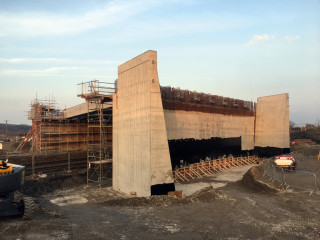The east side of Leeds is busy with construction activity, with – among other things – a new station slated for delivery in 2021 and building set to start on the long-awaited East Leeds Orbital Road (ELOR) later this year. Ahead of these infrastructure projects, new roads and bridges are also being built as part of an expansion of one of the city’s major business parks, Thorpe Park, with the new roads set to tie into the ELOR.
Thorpe Park currently houses around 600,000 sq ft (56,000 m2) of commercial office space, occupied by a range of big names including IBM, National Grid, Kier, Laing O’Rourke, Atkins, BAM and United Utilities. The original planning consent for the park gave its developer, Scarborough International, permission for a total of 1.5 million square feet (140,000 m2) of offices, but the recession caused a change of heart. “The park had got to six-hundred square feet when the world ended economically,” explains Scarborough International consultant Richard Burns. “The economic problems caused us to have a pause in our investment cycle, and it was a bit of a watershed moment.”
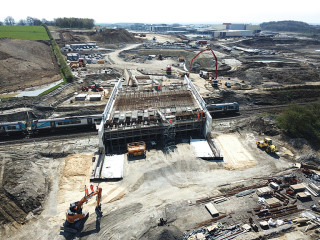
The developer realised that, instead of just building more offices on the remaining 40ha of its site, the park could be developed to include retail, leisure and amenity space. As a result, new plans were submitted for 400,000 sq ft (37,000 m2) of fashion-led retail, as well as leisure operators including a 10-screen Odeon cinema and eight restaurants. There will also be 300 new houses – to be built by Redrow Homes – and a park.
At its northern edge, the development site is bounded by a railway line that carries mainline trains between Leeds and York and also trans-Pennine trains to Manchester and beyond. The ELOR is set to cross this rail line at the north east corner of Thorpe Park, then run south through the new development area, before tying into the M1 at junction 46. As part of its plans to expand Thorpe Park, the developer has committed to build both the bridge over the railway line and the section of the ELOR that runs through Thorpe Park, which will initially be known as the Manston Lane Link Road.
In general, investors prefer to fund property developments once the infrastructure is in place, to avoid what they consider to be a financial risk associated with civil engineering projects. As Burns says: “This is an infrastructure-heavy development, so it needs an unusual investor.” But Scarborough International had previously been approached by UKTI (now the Department for International Trade) to help identify Northern Powerhouse projects, and Thorpe Park fitted the bill. As a result, UKTI was able to broker a deal for £162m in investment from Legal & General Capital, which had signed up to invest in major projects that fitted into the Northern Powerhouse agenda. “It’s been fortunate for the project that the Northern Powerhouse brand has come along,” admits Burns.
Scarborough International decided to split the road and bridge construction into two separate contracts, with the road being built by civil engineering firm I&H Brown, and the £5m bridge contract going to Galliford Try. The reason for splitting the two was to ensure that the riskier element – the bridge construction – did not have a knock-on impact on the programme to build the road.
“The key to the bridge project was that it was going to need track possessions,” explains Burns. “But there is a blanket ban on possessions on this line in the summer – from the end of March until October – because it is the main route to Manchester Airport. That means we could only build the bridge between October and March. So, in order to de-risk the project, the bridge was separated out.”
He adds: “As well as that, not all contractors would be capable of doing the bridge, and by separating them out it gave us a greater number of contractors who could build the road.” Both contractors are due to finish their elements of the infrastructure in August this year, while building contractor GMI Construction is set to deliver the retail and leisure complex ready for opening in October.
I&H Brown’s contract involves the design and construction of the new Manston Lane Link Road, a 950-metre long stretch of dual carriageway linking the M1 at junction 46 to Manston Lane at the north of the development site. It includes a new roundabout, a signalised junction into the residential site and a bridge for cyclists, pedestrians and horse riders – a double span box culvert structure spanning 33 metres with a 15-metre wide deck.
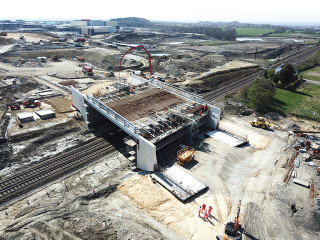
Galliford Try was awarded the contract to build the main bridge over the railway line in June 2017, although enabling works started four months earlier to clear vegetation ahead of the bird nesting season and to set up trackside monitoring. It was awarded on a design and build basis, under the NEC Option A lump sum form of contract. The contractor has used HBPW Consulting as its designer, with the original detailed design having been done by the client’s engineer, Pell Frischmann.
The bridge itself is a reinforced concrete structure, with a single 28m clear span over the railway tracks. At the moment there are only two tracks on this section of the line, but the new bridge is wide enough to allow two more to be added in future. It has also been designed with a 6m clearance from deck soffit to track, to allow for overhead line equipment if the line is ever electrified.
At 26m wide, the bridge can carry not only the dual carriageway road, but also a pedestrian footway on one side and a cycle path/bridleway on the other. It is skewed over the tracks at an angle of 14.9 degrees.
The bridge is an integral structure formed from nine 30m-long precast prestressed W10 concrete beams, produced by concrete specialist Shay Murtagh Precast, and an in situ concrete abutment. Galliford Try is also building a series of free standing reinforced concrete wing walls to contain an earth embankment.
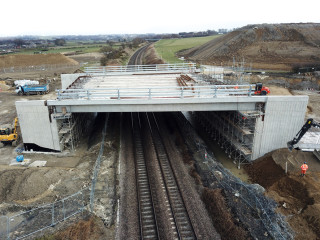
“What we’re constructing is the bridge itself and an element of the permanent embankment,” explains Galliford Try project manager Steve Jones, who says there is 33,000 m3, or 70,000 tonnes, of earthworks in his firm’s element of the work. Approximately 7,500 m3 of this is structural backfill. “Because the bridge is an integral [portal frame] structure, it can expand, so it requires a structural backfill that will allow the structure to move without putting any stress into the deck itself,” he explains.
The structural backfill is a 6N or 6P granular material, which has to be imported to site; all other fill material is site-won. “We are trying to reduce the amount of import, so we have site-won class 1 [granular material] and class 2 [cohesive],” says Jones. The embankment is designed to have a core of cohesive material, with a granular external cover to the side slopes.
Ground conditions on site are generally good, with approximately 3m of clay – which can be used as cohesive fill – on top of mudstone, siltstone and sandstone layers, all of which can be crushed for use as granular fill. To form the bridge foundations, Galliford Try dug down to the mudstone, which is very strong in compression, and used this as the base for reinforced concrete spread footings. A total of 2,140m3 of C50 structural concrete is required for the in situ elements of the bridge structure, with 280 m3 going in to form the bases alone.

Historically, the area on the east side of Leeds was mined for a type of coal known as Middleton Main coal, which was easily accessible from shallow, sloping seams. In some places the coal seams were so close to the surface that they were mined using “bell pits” - shafts sunk down to the coal and then opened out below ground in a bell shape as the coal was excavated.
These coal seams run beneath the entire Thorpe Park development site, including the new bridge. Galliford Try subcontracted geotechnical specialist Sirius Group to fill voids caused by coal mining beneath the structure on both sides of the railway line, with grout inserted through 100mm diameter tubes on a 3m grid to a level 1m deeper than the coal. “The deepest tubes on the south side went down to 17m below the formation level we’ve chosen to work to, and 12m on the north side,” recalls Jones.
“And on the north side, where the coal outcrops, we found nine bell pits. Some were identified from the topography – you can see the lumps in the ground – and then after site clearance you can clearly see circular pits that have been backfilled.” Sirius grouted these bell pits to prevent any subsidence in the future.
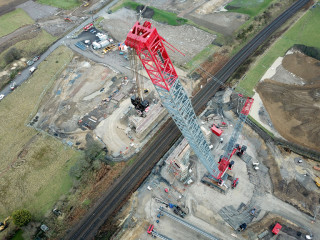
The grouting, foundation construction and even abutment pours could all be carried out without the need for track possessions, but the bridge beams could only be lifted in when the rail line was closed. This activity had to be scheduled to be carried out between October 2017 and March 2018 – the only time that the contractor was allowed full weekend possessions.
The nine deck beams are all the same length – 30 metres – but they varied in weight, as Jones explains: “Because it’s over a railway, and we had the restriction on the possession time, and also because, ideally, we want to reduce work at height, we decided to put the deck section and string course onto the edge beams before lifting. We also put on the permanent post and rail parapet, which creates an edge protection and reduces risk and working at height.
“But,” he adds, “it makes it heavier. A standard beam was 60 tonnes but an edge beam with the parapet was 130 tonnes. In order to lift that in, we used a 750-tonne capacity crawler crane.”
The crane – a Liebherr LR1750-2 – and its crew were supplied by heavy lifting specialist ALE, and spent eight weeks on site between 15th January and 9th March. It arrived on 50 wagons, and took five days to build on the south side of the railway line, and five to de-rig, with the aid of two telescopic mobile cranes.
ALE had recently taken delivery of the LR1750-2 when Galliford Try was looking for a way of lifting the Thorpe Park bridge beams. The crane has a wide boom system that gives it the same lifting capacity as some larger crawler cranes. Even so, it is a sizeable piece of equipment, and its 105-metre boom was visible from miles away.
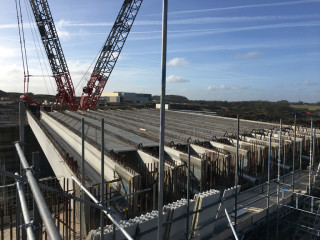
All the temporary works design and method statements for the crane erection and beam lifts had to be approved by both Network Rail and Leeds City Council. The three cranes all operated on platforms designed to cope with loads of 100 tonnes/m2, says Jones, adding: “Because we had got down to the very good mudstone, we only needed to form a 300mm thick platform of granular material.”
The main limiting factor for lifting was wind speed, with the maximum allowable speed being 11.2 m/s, or approximately 25mph. During the lifts, Galliford Try installed various elements of temporary works. The first was required to prevent the beams from slipping when they were placed on the abutment as – being an integral structure – there are no bearings. There is a 1m height difference across the bridge, falling from south to north, so the contractor installed a restraint to hold the beams in place. A similar solution of steel plates and bolts was also fixed on at the abutments to stop the edge beams from falling over, as the the addition of the string course and parapets makes them eccentrically weighted.
The deck will be poured over the live railway using GRP deck panels supplied by EMJ Plastics fixed between the beams as permanent formwork. These panels come with vertical stainless steel stiffeners and can withstand full live load during construction as well as the 275mm thick reinforced concrete deck. Galliford Try plans first to pour the deck up to the diaphragms, and then to pour the diaphragms separately. The deck pour will require 180m3 of concrete, then each diaphragm will take a further 90m3.
Work is also continuing on the free-standing wing walls, and the contractor is also placing some of the embankment fill and creating a temporary ramp for the road contractor to use. “We are doing an element of permanent works [for the road],” says Jones. “We will be putting in the waterproofing, the kerbing and the surfacing, except for the wearing course. Then the contractor can come through and surface the whole road in one hit.”
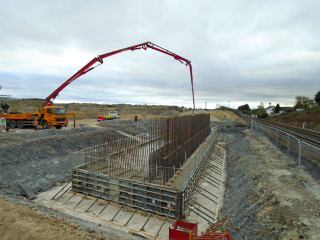
This article was first published in the May 2018 issue of The Construction Index magazine, which you can read for free at http://epublishing.theconstructionindex.co.uk/magazine/may2018/
UK readers can have their own copy of the magazine, in real paper, posted through their letterbox each month by taking out an annual subscription for just £50 a year. See www.theconstructionindex.co.uk/magazine for details.
Got a story? Email news@theconstructionindex.co.uk

